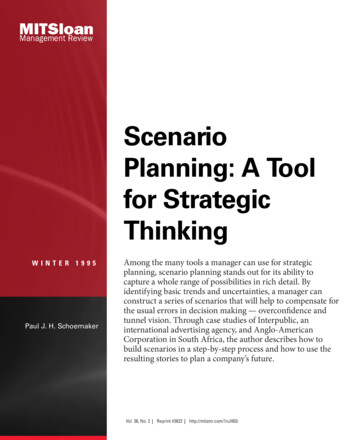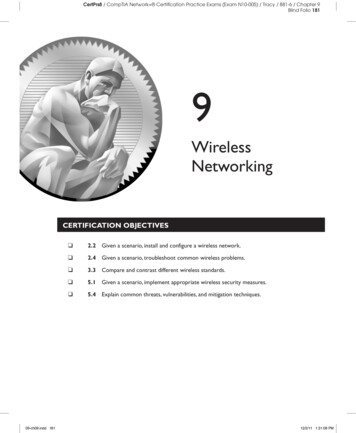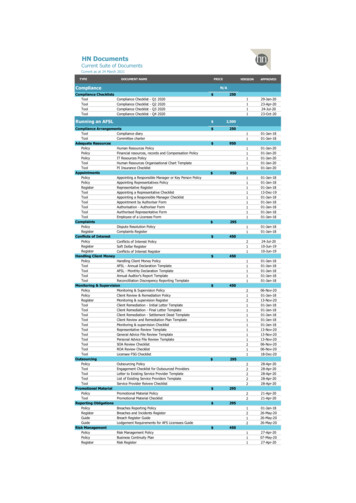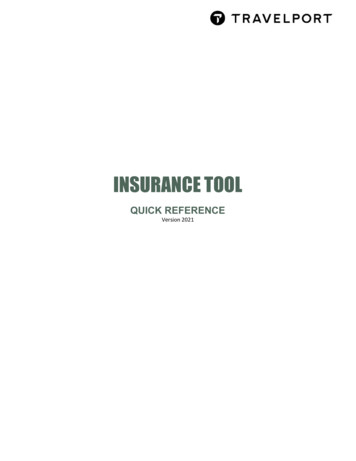
Transcription
ScenarioPlanning: A Toolfor StrategicThinkingWINTER 1995Paul J. H. SchoemakerAmong the many tools a manager can use for strategicplanning, scenario planning stands out for its ability tocapture a whole range of possibilities in rich detail. Byidentifying basic trends and uncertainties, a manager canconstruct a series of scenarios that will help to compensate forthe usual errors in decision making — overconfidence andtunnel vision. Through case studies of Interpublic, aninternational advertising agency, and Anglo-AmericanCorporation in South Africa, the author describes how tobuild scenarios in a step-by-step process and how to use theresulting stories to plan a company’s future.Vol. 36, No. 2Reprint #3622http://mitsmr.com/1nJI6Qi
Scenario Planning: A Tool forStrategic ThinkingPaul J.H. SchoemakerAMONG THE MANY TOOLS A MANAGER CAN USE FOR STRATEGIC PLANNING, SCENARIO PLANNING STANDS OUT FOR ITS ABILITY TO CAPTURE A WHOLE RANGE OFpossibilities in rich detail. By identifying basic trends and uncertainties, a managercan construct a series of scenarios that will help to compensate for the usual errors indecision making — overconfidence and tunnel vision. Through case studies ofInterpublic, an international advertising agency, and Anglo-American Corporation inSouth Africa, the author describes how to build scenarios in a step-by-step processand how to use the resulting stories to plan a company’s future. 1Early in this century, it was unclear how airplaneswould affect naval warfare. When BrigadierGeneral Billy Mitchell proposed that airplanesmight sink battleships by dropping bombs on them,U.S. Secretary of War Newton Baker remarked, “Thatidea is so damned nonsensical and impossible that I’mwilling to stand on the bridge of a battleship while thatnitwit tries to hit it from the air.” Josephus Daniels, Secretary of the Navy, was also incredulous: “Good God! Thisman should be writing dime novels.” Even the prestigiousScientific American proclaimed in 1910 that “to affirmthat the aeroplane is going to ‘revolutionize’ naval warfare of the future is to be guilty of the wildest exaggeration.”1In hindsight, it is difficult to appreciate why air power’spotential was unclear to so many. But can we predict thefuture any better than these defense leaders did? We areaffected by the same biases they were. It was probably ashard for them to evaluate the effect of airplanes in the1920s as it is for us to assess the impact over the nextdecades of multimedia, the human genome project,biotechnology, artificial intelligence, organ transplants,superconductivity, space colonization, and myriad otherdevelopments. The myopic statements in the sidebar remind us how frequently smart people have made thewrong assumptions about the future with great certainty.Managers who can expand their imaginations to see aSLOAN MANAGEMENT REVIEW/WINTER 1995Paul J.H. Schoemaker is the chairman of Decision Strategies International, Inc., and a professor in thedepartment of operations and information management, The WhartonSchool, University of Pennsylvania.wider range of possible futures will be much better positioned to take advantage of the unexpected opportunitiesthat will come along. And managers today have something those defense leaders did not have — scenarioplanning. Unfortunately, too few companies use it. Ifonly General Motors in the seventies had explored morefully the consequences of OPEC, the yuppie generation,globalization, environmentalism, and the importance ofquality and speed in manufacturing; or IBM and DigitalEquipment Corporation in the eighties, the full impactof the personal computer, which prompted the breakdown of the vertically integrated mainframe business and ashift toward distributed computing. Other examplesabound: Federal Express’s fiascos in Europe, Philips’s setback in electronic markets (despite its leading-edge technologies), Disney’s union and image problems with itstheme park in France, Sony in movies, etc.Scenario planning is a disciplined method for imagining possible futures that companies have applied to agreat range of issues. Royal Dutch/Shell has used scenarios since the early 1970s as part of a process for generating and evaluating its strategic options.2 Shell has beenconsistently better in its oil forecasts than other major oilcompanies, and first saw the overcapacity in the tankerbusiness and Europe’s petrochemicals. In the early 1980s,Anglo-American Corporation of South Africa convened aninternational group of experts to explore South Africa’sSCHOEMAKER25
future through scenarios, which provided a catalyst for profound politicalreform (as I explain later).3 Even theDutch Central Planning Bureau, a leading government agency traditionallywedded to econometrics and time seriesanalyses, issued wide-ranging, twentyfive-year global scenarios.4 And I havepersonally developed scenarios withclients to estimate future environmental liability, anticipate health-care costcontainment and regulatory control,assess the consequences of deregulationin electric utilities, determine the shifting dimensions of competition in financial services, develop a strategic vision for an R&D division, help WallStreet analysts see future changes in theindustries they track, and so forth.Although scenario planning has beenexamined by academics and describedby practitioners, no previous article hassought to bridge the theory and practice.5 I try to fill the gap by presenting asystematic methodology, with illustrations drawn from practice, that explainsthe rationale and process of scenarioplanning.They Believed It“Heavier-than-air flying machines are impossible.”Lord Kelvin, British mathematician, physicist, and president of the British Royal Society,c. 1895“With over fifty foreign cars already on sale here, the Japanese auto industry isn’t likelyto carve out a big slice of the U.S. market for itself.”Business Week, 2 August 1968“A severe depression like that of 1920-1921 is outside the range of probability.”The Harvard Economic Society, 16 November 1929“I think there is a world market for about five computers.”Thomas J. Watson, chairman of IBM, 1943“There is no reason for any individual to have a computer in their home.”Ken Olson, president, Digital Equipment Corporation, 1977“We don’t like their sound. Groups of guitars are on the way out.”Decca Recording Co. executive, turning down the Beatles in 1962“The phonograph . . . is not of any commercial value.”Thomas Alva Edison, inventor of the phonograph, c. 1880“No matter what happens, the U.S. Navy is not going to be caught napping.”Frank Knox, Secretary of the Navy, 4 December 1941, just before the Japanese attack onPearl Harbor“They couldn’t hit an elephant at this dist . . .”General John B. Sedgwick, last words, Battle of Spotsylvania, 1864Source: C. Cerf and V. Navasky, The Experts Speak (New York: Pantheon Books, 1984).A Planning ToolSuppose you are planning to climb a mountain. Previousplanning would provide you a detailed map describingthe constant elements of the terrain. Of course, this traditional planning tool is very valuable and, indeed, indispensable in this case. Just as geographical mapping isan honored art and science, so corporate mapping canbe very useful. However, it is incomplete. First, it is adistorted representation (i.e., any two-dimensional mapdistorts the earth’s surface). Second, it ignores the variable elements, such as weather, landslides, animals, andother hikers. The most important of these uncertaintiesis probably the weather, and one option is to gather detailed meteorological data of past seasons, perhaps usingcomputer simulations.However, scenario planning goes one step further. Itsimplifies the avalanche of data into a limited numberof possible states. Each scenario tells a story of how various elements might interact under certain conditions.When relationships between elements can be formalized, a company can develop quantitative models. It26SCHOEMAKERshould evaluate each scenario for internal consistencyand plausibility; for example, high visibility and heavysnowdrifts are an implausible combination. Although ascenario’s boundary might at times be fuzzy, a detailedand realistic narrative can direct your attention to aspectsyou would otherwise overlook. Thus a vivid snowdriftscenario (with low visibility) may highlight the need forskin protection, goggles, food supplies, radio, shelter,and so on.Scenario planning differs from other planning methods, such as contingency planning, sensitivity analysis,and computer simulations. First, contingency planningexamines only one uncertainty, such as “What if we don’tget the patent?” It presents a base case and an exceptionor contingency. Scenarios explore the joint impact ofvarious uncertainties, which stand side by side as equals.Second, sensitivity analysis examines the effect of achange in one variable, keeping all other variables constant. Moving one variable at a time makes sense forsmall changes. For instance, we might ask what will happen to oil demand if the gross national product increasesjust a fraction of a percent, keeping everything else con-SLOAN MANAGEMENT REVIEW/WINTER 1995
stant. However, if the change is much larger, other variables (such as interest rates, money supply, and so on)will not stay constant. Scenarios, on the other hand,change several variables at a time, without keeping oth-Scenario planning simplifiesthe avalanche of data intoa limited number ofpossible states.ers constant. They try to capture the new states that willdevelop after major shocks or deviations in key variables.Third, scenarios are more than just the output of acomplex simulation model. Instead they attempt to interpret such output by identifying patterns and clustersamong the millions of possible outcomes a computersimulation might generate. They often include elementsthat were not or cannot be formally modeled, such asnew regulations, value shifts, or innovations. Hence,scenarios go beyond objective analyses to include subjective interpretations.In short, scenario planning attempts to capture therichness and range of possibilities, stimulating decisionmakers to consider changes they would otherwise ignore. At the same time, it organizes those possibilitiesinto narratives that are easier to grasp and use than greatvolumes of data. Above all, however, scenarios are aimedat challenging the prevailing mind-set. Hence, scenarioplanning differs from the three aforementioned techniques in its epistemic level of analysis.Using ScenariosHow can you use scenarios? In simplified form, peoplecan use the technique to make individual decisions. Afunction, say, information systems, can also use scenariodevelopment to anticipate changes in its role. But perhaps most beneficial is its use in corporatewide strategicplanning and vision building. Organizations facing thefollowing conditions will especially benefit from scenario planning: Uncertainty is high relative to managers’ ability to predict or adjust. Too many costly surprises have occurred in the past. The company does not perceive or generate new opportunities. The quality of strategic thinking is low (i.e., too routinized or bureaucratic).SLOAN MANAGEMENT REVIEW/WINTER 1995 The industry has experienced significant change or isabout to. The company wants a common language and framework, without stifling diversity. There are strong differences of opinion, with multipleopinions having merit. Your competitors are using scenario planning.Once it develops strategic scenarios, the executiveteam might simply disseminate them throughout theorganization to stimulate managerial thinking. Or itmight use scenarios for evaluating proposals. For example, corporate executives might ask the strategic businessunits to submit investment proposals that project cashflow in each of several scenarios.6In short, the technique is applicable to virtually anysituation in which a decision maker would like to imagine how the future might unfold. In this article, I focusparticularly on developing scenarios for strategic planning, but the same basic method applies to other situations of decision making under uncertainty.Constructing ScenariosScenario planning attempts to compensate for two common errors in decision making — underprediction andoverprediction of change. Most people and organizations are guilty of the first error.7 Although change in allaspects of our lives is accelerating dramatically, we tendto imagine the future without such a rate of change.Think how hard it would have been a hundred yearsago to imagine the factors that propelled society intotoday’s brave, new technological world where cars, airplanes, televisions, stereos, computers, ice-makers, andpacemakers are commonplace. Yet a small group of futurists overpredicted, expecting levels of change that failedto materialize, notably in medicine (we are losing the waragainst cancer), artificial intelligence (robots don’t yet outsmart us), and space travel (most of us are still earthbound). Often these forecasters were scientists or entrepreneurs whose general faith in technology, or whosemomentary successes in science or business, inducedunjustified leaps of faith.8Scenario planning, then, allows us to chart a middleground between under- and overprediction. It helps expand the range of possibilities we can see, while keepingus from drifting into unbridled science fiction. Scenarioplanning does this by dividing our knowledge into twoareas: (1) things we believe we know something aboutand (2) elements we consider uncertain or unknowable.The first component casts the past forward, recognizingthat our world possesses considerable momentum andSCHOEMAKER27
continuity. For example, we can safely make assumptions about demographic shifts (such as increases in theaverage age) and substitution effects of new technologies(e.g., digital recording will replace analog tapes and cassettes). Of course, nothing is ever absolutely certain —not even death and taxes — but to leave everything uncertain will cause paralysis in most organizations. Thechallenge is to separate aspects you are very confidentabout (and willing to bet the farm on) from those thatare largely uncertain.Obvious examples of uncertain aspects are future interest rates, oil prices, results of political elections, ratesof innovation, and so forth. There are also less obviousexamples, such as the probability that certain world-Asimple approach is to identifyextreme worlds by putting allpositive elements in one andall negatives in another.views will reign (e.g., monetarism versus supply-sideeconomics). It is not important to account for all thepossible outcomes of each uncertainty; simplifying thepossible outcomes is sufficient for scenario planning.For instance, you may want to think in terms of threepossible interest rates (high, medium, and low) ratherthan hundreds of them. The purpose is not to cover allpossibilities, but to circumscribe them.Since scenarios depict possible futures but not specific strategies to deal with them, it makes sense to inviteoutsiders into the process, such as major customers, keysuppliers, regulators, consultants, and academics. Oryou can start with trends and scenarios that others havedeveloped (e.g., de Jong and Zalm’s four global scenarios, “global shift,” “European renaissance,” “global crisis,” and “balanced growth”).9 The objective is to see thefuture broadly in terms of fundamental trends and uncertainties. Line managers develop the basic ideas, whilestaff people, such as planners, develop the written version later, fill in the gaps, find new data, and so forth.The overall purpose is to build a shared framework forstrategic thinking that encourages diversity and sharperperceptions about external changes and opportunities.Next I describe the process for developing scenarios.1. Define the Scope. The first step is to set the timeframe and scope of analysis (in terms of products, markets, geographic areas, and technologies). Time framecan depend on a number of factors: the rate of technol-28SCHOEMAKERogy change, product life cycles, political elections, competitors’ planning horizons, and so forth. Once you havedetermined an appropriate time frame, ask what knowledge would be of greatest value to the organization thatfar down the road. It is useful to look at the past andthink about what you wish you had known then, thatyou know now.10 What have been past sources of uncertainty and volatility? Let’s say you’re developing ten-yearscenarios. Look back over the past ten years at thechanges that have occurred in your department, organization, industry, region, country, and even the world. Youshould anticipate a similar amount of change or evenmore in the next ten years. Ideally, groups (e.g., the wholemanagement team) will participate in this part of the process. Their unstructured concerns and anxieties are oftengood starting points for scenario planning.2. Identify the Major Stakeholders. Who will have aninterest in these issues? Who will be affected by them?Who could influence them? Obvious stakeholders include customers, suppliers, competitors, employees, shareholders, government, and so forth. Identify their currentroles, interests, and power positions, and ask how theyhave changed over time and why. For example, in theenvironmental area, judges, scientists, lawyers, journalists,and regulators are increasingly powerful stakeholders.3. Identify Basic Trends. What political, economic, societal, technological, legal, and industry trends are sureto affect the issues you identified in step one? For example, a company concerned with the future of environmental issues might identify trends such as increasingenvironmental regulation, continuing growth of environmental interest groups, scientific advances in molecular biology, and an increasingly liberal judiciary due toa Democratic president. Briefly explain each trend, including how and why it exerts its influence on your organization. It may be helpful to list each trend on a chartor so-called influence diagram to identify its impact onyour present strategy as positive, negative, or uncertain.Everyone participating in the process must agree thatthese trends will continue; any trend on which there isdisagreement (within the time frame) belongs in the nextstep.4. Identify Key Uncertainties. What events, whoseoutcomes are uncertain, will significantly affect the issuesyou are concerned with? Again, consider economic, political, societal, technological, legal, and industry factors. Willthe next U.S. president be a Republican or Democrat?Will a particular piece of legislation be passed? Will a newtechnology be developed? What will consumers value inthe future? For each uncertainty, determine possible outcomes (e.g., Republican or Democrat; legislation passedSLOAN MANAGEMENT REVIEW/WINTER 1995
or not passed; technology developed or not developed;whether consumers value service or price). Again, it’sbest to keep these outcomes simple, with a few possibilities at most.You may also want to identify relationships amongthese uncertainties, since not all combinations mayoccur. For example, if one economic uncertainty is “levelof unemployment” and the other “level of inflation,”then the combination of full employment and zero inflation may be ruled out as implausible. (Later I show howa correlation matrix can help identify such linkagesamong all pairs of key uncertainties.)5. Construct Initial Scenario Themes. Once you identify trends and uncertainties, you have the main ingredients for scenario construction. A simple approach is toidentify extreme worlds by putting all positive elementsin one and all negatives in another. (Note that positive ornegative is defined here relative to the current strategy.What seems to be a negative scenario at first may laterprove to be one of innovation and hidden opportunity.)Alternatively, the various strings of possible outcomes(which jointly define a scenario) can be clustered aroundhigh versus low continuity, degree of preparedness, turmoil, and so on. Another method for finding some initial themes is to select the top two uncertainties andcross them (as illustrated later in the Anglo-Americancase). This technique makes the most sense if some uncertainties are clearly more important than others.6. Check for Consistency and Plausibility. The simple worlds you have just made are not yet full-fledgedscenarios, because they probably have internal inconsistencies or lack a compelling story line. There are at leastthree tests of internal consistency, dealing with thetrends, the outcome combinations, and the reactions ofmajor stakeholders. First, are the trends compatiblewithin the chosen time frame? If not, remove the trendsthat don’t fit. Second, do the scenarios combine outcomes of uncertainties that indeed go together? Asnoted above, full employment and zero inflation do notgo together, so eliminate that possible pairing or scenario. Third, are the major stakeholders (e.g., OPEC)placed in positions they do not like and can change?(For example, OPEC may not tolerate low oil prices forvery long.) If so, your scenario will evolve into anotherone. Try to describe this end scenario, which is morestable. The stakeholder test is especially critical whenbuilding macroscenarios involving governments, international organizations (e.g., the International MonetaryFund, the World Bank, the United Nations) or stronginterest groups like OPEC.117. Develop Learning Scenarios. From this process ofSLOAN MANAGEMENT REVIEW/WINTER 1995constructing simple scenarios and checking them forconsistency, some general themes should emerge. Theinitial scenarios provide future boundaries, but theymay be implausible, inconsistent, or irrelevant. The goalis to identify themes that are strategically relevant andthen organize the possible outcomes and trends aroundthem. Although the trends, by definition, appear in allthe scenarios, they can be given more or less weight orattention in different scenarios.For example, a company concerned with its future liability for hazardous waste might construct three scenarios: “Superfund II,” “Environmentalists Lose,” and“Compromise.” The political trends and key uncertainties may get more play in “Superfund II,” while legaltrends and the health of the economy may feature moreprominently in the other two scenarios. Naming thescenarios is also important. A scenario is a story; by capturing its essence in a title, you make the story easy tofollow and remember. At this stage, you have constructed learning scenarios, which are tools for research andstudy, rather than for decision making. The titles andthemes are focal points around which to develop andtest the scenarios.8. Identify Research Needs. At this point, you mayneed to do further research to flesh out your understanding of uncertainties and trends. The learning scenarios should help you find your blindspots. For example, do you really understand how a key stakeholder(say, a regulator or judge) will behave in a given scenario? Often, companies know a lot about their own industry but little beyond the fringes, from which the innovations may come. So you may wish to study newtechnologies that are not yet in the mainstream of yourindustry but may be someday. Consider the developments in multimedia, where personal computers, telecommunication, entertainment, databases, and television are merging into new products and markets. Acompany like Apple Computer, traditionally focused onmaking personal computers, must now master new domains, such as electronic miniaturization (to exploitportability), artificial intelligence (to make PCs smarter),information highways (to connect), and so on.9. Develop Quantitative Models. After completing additional research, you should reexamine the internal consistencies of the scenarios and assess whether certain interactions should be formalized via a quantitative model.For example, Royal Dutch/Shell has developed a modelthat keeps oil prices, inflation, GNP growth, taxes, oilinventories, interest rates, and so forth in plausible balances. As managers imagine different outcomes of keyuncertainties, they can use formal models to keep fromSCHOEMAKER29
straying into implausible scenarios.12 The models canalso help to quantify the consequences of various scenarios, say, in terms of price behavior, growth rates,market shares, and so on.10. Evolve toward Decision Scenarios. Finally, in aniterative process, you must converge toward scenariosthat you will eventually use to test your strategies andgenerate new ideas. Retrace steps one through eight tosee if the learning scenarios (and any quantitative models from step nine) address the real issues facing yourcompany. Are these the scenarios that you want to giveothers in the organization to spur their creativity or helpthem appreciate better the up- and downside risks inScenarios should describegenerically different futuresrather than variationson one theme.various strategies? If yes, you are done. If not, repeat thesteps and refocus your scenarios the way an artist judgesthe balance and focal point in a painting. Half of thisjudgment is art, half is science.13How can you determine if your final scenarios are anygood? The first criterion is relevance. To have impact,your scenarios should connect directly with the mentalmaps and concerns of the users (e.g., senior executives,middle managers, etc.). Second, the scenarios should beinternally consistent (and be perceived as such) to be effective. Third, they should be archetypal. That is, theyshould describe generically different futures rather thanvariations on one theme. Fourth, each scenario ideallyshould describe an equilibrium or a state in which thesystem might exist for some length of time, as opposedto being highly transient. It does an organization little goodto prepare for a possible future that will be quite shortlived. In short, the scenarios should cover a wide range ofpossibilities and highlight competing perspectives (withinand outside the firm), while focusing on interlinkages andthe internal logic within each future.Scenario Planning at an Ad AgencyThe advertising industry has experienced a flurry oftakeovers and mergers, which has resulted in giant agencysystems like the Interpublic Group, Saatchi and Saatchi,the Omnicom Group, and Dentsu in Japan. A few yearsago, I helped Interpublic develop scenarios to assess30SCHOEMAKERTable 1 Some Past Changes in the U.S. AdvertisingIndustry1930s Radio develops into a mature medium.Celebrities’ testimony used extensively.Social Security supplements the incomes of senior citizens.Local breweries flourish (after Prohibition).1940s War unites the country; patriotism flourishes.TV blossoms as a new communications medium.Population shifts to the suburbs.Supermarkets and shopping malls develop.Air travel expands greatly.1950s Target markets and focused ads get attention.Service and financial institutions grow.Color TVs start to replace black and white.Psychoanalysis of consumers becomes prevalent.Trademark and patent infringement results inheavy litigation.1960s Ads are careful to avoid provincialism and prejudice.Negative advertising about competitors emerges.Banks start to issue credit cards.Computer is a new word and new product.Big business expands; agencies follow suit.1970s Segmentation and agency creativity emphasized.TV fails to “kill” radio; broadcasting shifts to narrowcasting.Vietnam is stalemated.Watergate is revealed.Gasoline is in short supply.Consumer groups and environmentalists gain power.Japanese invade and dominate U.S. markets in electronicsand cars.1980s Use of personal computers and servers (replacingmainframes) increases. Point-of-sale scanning technology provides real-timemarket data. Money and commodity markets (especially U.S. dollar) arevolatile. Global mega-agencies form via merger/acquisition. Communism crumbles worldwide (with a few exceptions). Media are fragmented. Brand names decline.whether the global agency concept, which MarionHarper pioneered at the agency, was still viable. Wheninterviewing key advertising executives in 1990, I askedthem about past changes in the industry (and its caus-SLOAN MANAGEMENT REVIEW/WINTER 1995
es), current trends, key uncertainties (and their interrelationships), and their overall views of the future.In the distant past, advertising agencies had beenmostly order takers that simply executed ad placement.The traditional price structure of a 15 percent commission closely reflected the number of calls and paperworkneeded for such placements. Improvements in communications technology and the emergence of mass mediareduced the agency’s placement costs. To justify theirhigher profit margins, agencies started to add servicesfor clients such as more sophisticated designs, marketresearch, and elaborate pitches for new business. Around1960, clients began to view the continual addition ofservices as not worth the implicit price they were payingvia the 15 percent commission. Skyrocketing mediacosts in the 1970s and 1980s for television created excessive commissions for agencies that became increasinglyhard to justify with additional, but unnecessary, services.Thus the 12 percent to 15 percent commission structurecame under pressure, resulting in reductions in the percentage (to as low as 5 percent to 7 percent) or fee-forservice arrangements.In the meantime, however, the costs of delivering advertising had started to climb during the 1960s, aftermany decades of gradual decline. These cost increases reflected the general shift away from broadcasting (inwhich one message reaches many millions of consumers)to narrowcasting (where many messages reach small, targeted segments). Increasingly fine segmentation, due toreduced costs of identifying and addressing these segments, meant a fragmentation of media. For instance,Farm Journal recognizes about 5,000 different segm
The quality of strategic thinking is low (i.e., too rou-tinized or bureaucratic). The industry has experienced significant change or is about to. The company wants a common language and frame-work, without stifling diversity. There are strong dif






![Informatica Interview Questions and Answers [Scenario-Based]](/img/2/informatica-interview-questions-and-answers-scenario-based-1.jpg)




